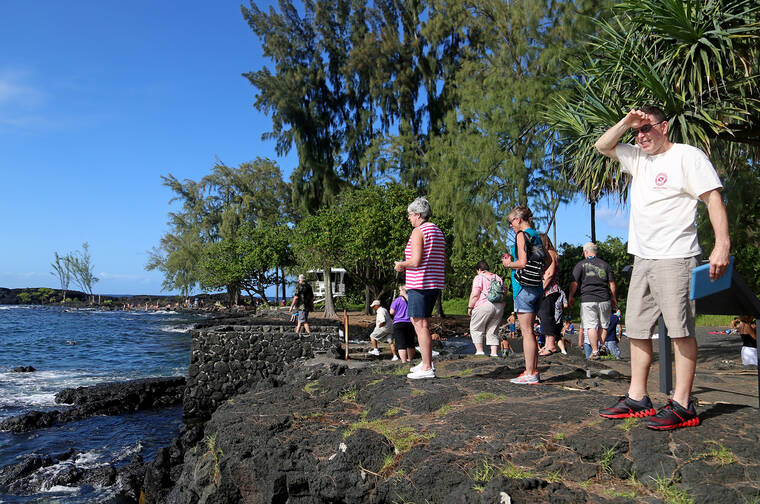Two beach parks in Keaukaha are the test bed for a new pair of county and state programs to cultivate more mindful behavior in visitors.
A partnership between the Hawaii Tourism Authority, Hawaii County and the Island of Hawaii Visitors Bureau announced two conjoined programs that will employ local stewards to educate visitors to Richardson and Lehia beach parks in Keaukaha.
Through the Keaukaha Steward Pilot Program, the state and county has hired four Keaukaha residents to gather data about visitor behavior and guide visitors toward more pono behavior that will be less disruptive to the community and the environment.
At the same time, the Community Cultural-Based Education Program will provide funding to the Keli‘i William Ioane Legacy Foundation to gather cultural and historical knowledge about Keaukaha that will be shared with visitors through the stewards.
Funding is provided by HTA and the county and allocates a total of $115,000 to both programs, $90,000 of which goes to the steward program.
“They’re a convergence of a few factors,” said Ilihia Gionson, HTA public affairs officer. “With our Destination Management Action Plan going on, we wanted to figure out the challenges and opportunities facing different places around the state. And Keaukaha is disproportionately impacted by visitors.”
Gionson said that challenges in managing visitor destinations come from a lack of one of the “three I’s”: infrastructure, information and invitation.
Sometimes, he said, visitors can have negative impacts because of unavailable or substandard infrastructure, or because they don’t know where to go or how to behave.
“But sometimes, they don’t have the invitation, and they’re going to places they’re not supposed to be, like private property,” Gionson said.
Steward Susan Champeny said that the number of daily users at Richardson can range from 250 to 1,400 depending on the day, time of year, and whether a cruise ship has arrived. But she added that when the ratio of local users to visitors skews in favor of visitors, “all the rules of the road go out the window.”
Champeny, who primarily gathers data on user behavior, said that she rates drivers at the parks on whether their behavior is pono, and often finds that 50% or more drivers are not being considerate of the community, whether that means parking on lawns, in other people’s driveways, or otherwise disregarding posted rules.
“And if you’re not pono, that means you’re not safe,” Champeny said.
County Parks and Recreation Deputy Director Michelle Hiraishi said the steward program stems from informal “friends of the park” agreements her department often makes with community groups who help clean up and manage parks around the county.
“We have 302 facilities and 550 staff,” Hiraishi said. “But even with that many staff, there’s no way we can have eyes on all of our parks.”
The steward program formalizes those community agreements and, critically, raises those volunteer roles to paid part-time positions, Hiraishi said.
Champeny said all the stewards are Keaukaha residents, because they are the ones most knowledgeable about the area and most impacted by its misuse.
“When the first cruise ship came in (after COVID-19), 250 visitors came to the beach without warning,” Champeny said. “I think that ticked the neighborhood off, like they never thought to give us a heads-up.
“Like the area was just going to go back to the way it was with people treating it like an airport, only without the wands.”
Because it is only a pilot program, the steward program will end in December, although Gionson said HTA is willing to extend it if it is found to be effective at improving the area. Champeny said that she hopes the rate of visitors rated “pono” will be significantly higher by the end of the year.
“I think when people think about the impacts of tourism, people focus on the big numbers. Like, 9 million visitors a year,” Gionson said. “But a lot of times, it’s the small numbers. It’s not the 9 million visitors, it’s the nine people who went somewhere they weren’t supposed to go. If we can do something about those nine people, maybe we can see changes.”
Email Michael Brestovansky at mbrestovansky@hawaiitribune-herald.com.









